When it comes to the management of back & knee pain, injections have emerged as a powerful therapy technique, giving patients all over the world with relief and improving their quality of life. The epidural and hydrocortisone injections are two of these treatments that have proven to be extremely effective, and as a result, they have become increasingly popular. Queens residents with knee pain should better understand these therapies, and allow themselves to have a better understanding of their benefits and the essential role they play in knee & back pain management.
Epidural
Epidural injections, which are most commonly linked with labor and delivery, are not exclusive to the field of obstetrics. They have been widely used as a therapeutic intervention for back pain, specifically when the pain originates from a spinal condition, such as lumbar spinal stenosis or a herniated disc, that radiates to the whole body. This type of knee discomfort has become increasingly common in recent years. During the operation, a local anesthetic and, frequently, a corticosteroid are injected into the epidural area of the spine. This reduces inflammation and, as a result, lessens or eliminates the patient’s level of discomfort. Patients who receive epidural injections typically have a significant decrease in pain, improvement in mobility, and enhancement of their general function.
Hydrocortisone
On the other hand, hydrocortisone injections have been shown to be an effective weapon in the battle against localized knee pain, which is frequently brought on by conditions such as osteoarthritis or knee bursitis. These types of knee pain have been shown to be particularly difficult to treat. Cortisol is a hormone that is naturally created in the body to fight inflammation. Hydrocortisone, a synthetic corticosteroid, acts in a manner that is similar to that of cortisol.
Injections of hydrocortisone that are given directly into the knee joint provide fast and significant pain relief. These injections work on the spot to minimize inflammation and edema that may be caused by the knee. Patients whose knee pain has not responded well to oral drugs or physical therapy have found them to be of significant benefit from these injections.
Patients who receive hydrocortisone injections are able to engage more actively in physical therapy sessions, which is an essential component of complete knee pain care. While hydrocortisone injections can provide sufferers of chronic knee pain with momentary respite, this treatment also enables patients to experience less discomfort during their sessions. Patients are able to strengthen their knee muscles with the help of these injections since the acute discomfort is alleviated, which in turn improves joint mobility and stability.
Conclusion
Both epidural and hydrocortisone injections have completely changed the way knee rehabilitation is approached. People who suffer from knee issues are given the opportunity to live lives that are less painful and more active as a result of their capacity to reduce knee pain and improve knee functionality. These therapies hold promise for refining our approach to knee pain management, bringing up new paths for patient care and recovery as research continues to advance.
This article was contributed with help from our featured Queens Ledger Pain Doctor:
Elite Pain Queens Back Neck Knee PRP & Cortisone Injections by Dr Y. Abrakhimov NYC
62-40 Woodhaven Blvd Suite p17, Queens, NY 11374 (718) 200-8846



